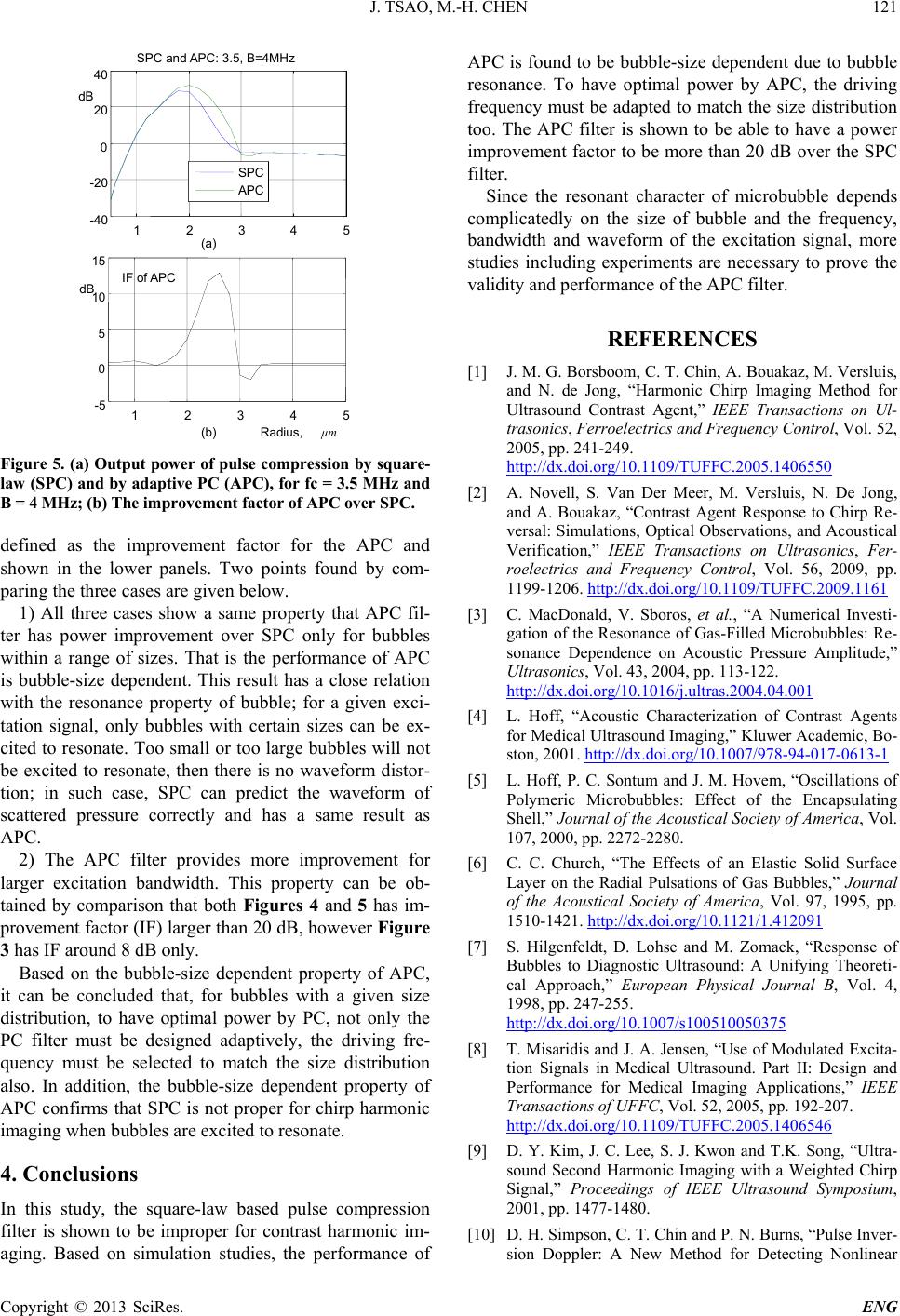
J. TSAO, M.-H. CHEN
Copyright © 2013 SciRes. ENG
Figure 5. (a) Output pow er of pulse compressi on by square-
law (SPC) and by adaptive PC (APC), f or fc = 3.5 MHz and
B = 4 MHz; (b) The im p ro v em ent factor of APC o v er SPC.
defined as the improvement factor for the APC and
shown in the lower panels. Two points found by com-
paring the three cases are given below.
1) All three cases show a same property that APC fil-
ter has power improvement over SPC only for bubbles
within a range of sizes. That is the performance of APC
is bubble-size dependent. This result has a close relation
with the resonance property of bubble; for a given exci-
tation signal, only bubbles with certain sizes can be ex-
cited to resonate. Too small or too large bu bbles will not
be excited to resonate, then there is no waveform distor-
tion; in such case, SPC can predict the waveform of
scattered pressure correctly and has a same result as
APC.
2) The APC filter provides more improvement for
larger excitation bandwidth. This property can be ob-
tained by comparison that both Figures 4 and 5 has im-
provement factor (IF) larger than 20 dB, however Figure
3 has IF ar ound 8 dB only .
Based on the bubble-size dependent property of APC,
it can be concluded that, for bubbles with a given size
distribution, to have optimal power by PC, not only the
PC filter must be designed adaptively, the driving fre-
quency must be selected to match the size distribution
also. In addition, the bubble-size dependent property of
APC confirms that SPC is not proper for chirp harmonic
imagi ng when bubbl e s are excit e d t o re s o na te.
4. Conclusions
In this study, the square-law based pulse compression
filter is shown to be improper for contrast harmonic im-
aging. Based on simulation studies, the performance of
APC is found to be bubble-size dependent due to bubble
resonance. To have optimal power by APC, the driving
frequency must be adapted to match the size distribution
too. The APC filter is shown to be able to have a power
imp ro ve men t factor to be more than 20 dB over the SPC
filter.
Since the resonant character of micro bubble depends
complicatedly on the size of bubble and the frequency,
bandwidth and waveform of the excitation signal, more
studies including experiments are necessary to prove the
validity and performance of the APC filter.
REFERENCES
[1] J. M. G. Borsboom, C. T. Chin, A. Bouakaz, M. Versluis,
and N. de Jong, “Harmonic Chirp Imaging Method for
Ultrasound Contrast Agent,” IEEE Transactions on Ul-
trasonics, Ferroelectrics and Frequency Control, Vol. 52,
2005, pp. 241-249.
http://dx.doi.org/10.1109/TUFFC.2005.1406550
[2] A. Novell, S. Van Der Meer, M. Versluis, N. De Jong,
and A. Bouakaz, “Contrast Agent Response to Chirp Re-
versal: Simulations, Optical Observations, and Acoustical
Verification,” IEEE Transactions on Ultrasonics, Fer-
roelectrics and Frequency Control, Vol. 56, 2009, pp.
1199-1206. http://dx.doi.org/10.1109/TUFFC.2009.1161
[3] C. MacDonald, V. Sboros, et al., “A Numerical Investi-
gation of the Resonance of Gas-Filled Microbubbles: Re-
sonance Dependence on Acoustic Pressure Amplitude,”
Ultrasonics, Vol. 43, 2004, pp. 113-122.
http://dx.doi.org/10.1016/j.ultras.2004.04.001
[4] L. Hoff, “Acoustic Characterization of Contrast Agents
for Medical Ultrasound Imaging,” Kluwer Academic, Bo-
ston, 2001. http://dx.doi.org/10.1007/978-94-017-0613-1
[5] L. Hoff, P. C. Sontum and J. M. Hovem, “Oscillations of
Polymeric Microbubbles: Effect of the Encapsulating
Shell,” Journal of the Acoustical Society of America, Vol.
107, 2000, pp. 2272-2280.
[6] C. C. Church, “The Effects of an Elastic Solid Surface
Layer on the Radial Pulsations of Gas Bubbles,” Journal
of the Acoustical Society of America, Vol. 97, 1995, pp.
1510-1421. http://dx.doi.org/10.1121/1.412091
[7] S. Hilgenfeldt, D. Lohse and M. Zomack, “Response of
Bubbles to Diagnostic Ultrasound: A Unifying Theoreti-
cal Approach,” European Physical Journal B, Vol. 4,
1998, pp. 247-255.
http://dx.doi.org/10.1007/s100510050375
[8] T. Misaridis and J. A. Jens en, “Use of Modulated Excita-
tion Signals in Medical Ultrasound. Part II: Design and
Performance for Medical Imaging Applications,” IEEE
Transactions of UFFC, Vol. 52, 2005, pp. 192-207.
http://dx.doi.org/10.1109/TUFFC.2005.1406546
[9] D. Y. Kim, J. C. Lee, S. J. Kwon and T.K. Song, “Ultra-
sound Second Harmonic Imaging with a Weighted Chirp
Signal,” Proceedings of IEEE Ultrasound Symposium,
2001, pp. 1477-1480.
[10] D. H. Simpson, C. T. Chin and P. N. Burns, “Pulse Inver-
sion Doppler: A New Method for Detecting Nonlinear